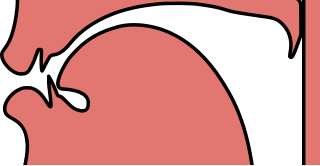Voiced alveolo-palatal fricative
Consonantal sound represented by ⟨ʑ⟩ in IPA From Wikipedia, the free encyclopedia
The voiced alveolo-palatal sibilant fricative is a type of consonantal sound, used in some spoken languages. The symbol in the International Phonetic Alphabet that represents this sound is ⟨ʑ⟩ ("z", plus the curl also found in its voiceless counterpart ⟨ɕ⟩), and the equivalent X-SAMPA symbol is z\. It is the sibilant equivalent of the voiced palatal fricative, and as such it can be transcribed in IPA with ⟨ʝ˖⟩.
| Voiced alveolo-palatal fricative | |||
|---|---|---|---|
| ʑ | |||
| IPA number | 183 | ||
| Audio sample | |||
| Encoding | |||
| Entity (decimal) | ʑ | ||
| Unicode (hex) | U+0291 | ||
| X-SAMPA | z\ | ||
| Braille | |||
| |||
Features
Summarize
Perspective

Features of the voiced alveolo-palatal fricative:
- Its manner of articulation is sibilant fricative, which means it is generally produced by channeling air flow along a groove in the back of the tongue up to the place of articulation, at which point it is focused against the sharp edge of the nearly clenched teeth, causing high-frequency turbulence.
- Its place of articulation is alveolo-palatal. This means that:
- Its place of articulation is postalveolar, meaning that the tongue contacts the roof of the mouth in the area behind the alveolar ridge (the gum line).
- Its tongue shape is laminal, meaning that it is the tongue blade that contacts the roof of the mouth.
- It is heavily palatalized, meaning that the middle of the tongue is bowed and raised towards the hard palate.
- Its phonation is voiced, which means the vocal cords vibrate during the articulation.
- It is an oral consonant, which means air is allowed to escape through the mouth only.
- It is a central consonant, which means it is produced by directing the airstream along the center of the tongue, rather than to the sides.
- Its airstream mechanism is pulmonic, which means it is articulated by pushing air solely with the intercostal muscles and abdominal muscles, as in most sounds.
Occurrence
| Language | Word | IPA | Meaning | Notes | |
|---|---|---|---|---|---|
| Abkhaz | ажьа | [aˈʑa] | 'hare' | See Abkhaz phonology | |
| Adyghe | жьау | [ʑaːw] | 'shadow' | ||
| Catalan | Eastern[1] | ajut | [əˈʑut] | 'help' (n.) | See Catalan phonology |
| All dialects | caixmir | [kə(j)ʑˈmiɾ] | 'Cashmere' | ||
| Chinese | Jiangshan | 十 | [ʑyœʔ] | 'ten' | |
| Taiwanese Hokkien | 今仔日/kin-á-ji̍t | [kɪn˧a˥ʑɪt˥] | 'today' | ||
| Czech | život | [ʑɪvot] | 'life' | See Czech phonology | |
| English | Ghana[2] | vision | [ˈviʑin] | 'vision' | Educated speakers may use [ʒ], which this phoneme corresponds to in other dialects.[2] |
| Japanese | 火事/kaji | [kaʑi] | 'fire' | Found in free variation with [d͡ʑ] between vowels. See Japanese phonology | |
| Kabardian | жьэ | [ʑa] | 'mouth' | ||
| Lower Sorbian[3] | źasety | [ʑäs̪ɛt̪ɨ][stress?] | 'tenth' | ||
| Luxembourgish[4] | héijen | [ˈhɜ̝ɪ̯ʑən] | 'high' | Allophone of /ʁ/ after phonologically front vowels; some speakers merge it with [ʒ]. Occurs in only a few words.[4] See Luxembourgish phonology | |
| Pa Na | [ʑu˧˥] | 'small' | |||
| Polish[5] | źrebię | ⓘ | 'foal' | Also denoted by the digraph ⟨zi⟩. See Polish phonology | |
| Portuguese[6][7][8] | magia | [maˈʑi.ɐ] | 'magic' | Also described as palato-alveolar [ʒ].[9][10] See Portuguese phonology | |
| Romani | Kalderash[11] | ʒal | [ʑal] | 'he/she/it goes' | Realized as [d͡ʒ] in conservative dialects. |
| Romanian | Transylvanian dialects[12] | geană | [ˈʑanə] | 'eyelash' | Realized as [d͡ʒ] in standard Romanian. See Romanian phonology |
| Russian | Conservative Moscow Standard[13] | позже | [poʑːe] | 'later' | Somewhat obsolete in many words, in which most speakers realize it as hard [ʐː].[13] Present only in a few words, usually written ⟨жж⟩ or ⟨зж⟩. See Russian phonology |
| Sema[14] | aji | [à̠ʑì] | 'blood' | Possible allophone of /ʒ/ before /i, e/; can be realized as [d͡ʑ ~ ʒ ~ d͡ʒ] instead.[14] | |
| Serbo-Croatian | Serbian and Croatian[15] | puž će | [pûːʑ t͡ɕe̞] | 'the snail will' | Allophone of /ʒ/ before /t͡ɕ, d͡ʑ/.[15] See Serbo-Croatian phonology |
| Some speakers of Montenegrin | źenica/з́еница | [ʑȇ̞nit̻͡s̪a̠] | 'pupil' | Phonemically /zj/ or, in some cases, /z/. | |
| Spanish | Paraguayan[16] | carro | [ˈkaʑo] | 'car' | Dialectal realization of /r/ and allophone of /ɾ/ after /t/. |
| Tatar | Kazan dialect (standard Tatar) | җан / can | [ʑan] | 'soul' | In Mishar Dialect, letter җ / c is [d͡ʒ].[17] |
| Uzbek[18] | [example needed] | ||||
| Xumi | Upper[19] | [ʑɐ̝˦] | 'beer, wine' | ||
| Yi | ꑳ/yi | [ʑi˧] | 'tobacco' | ||
See also
Notes
References
External links
Wikiwand - on
Seamless Wikipedia browsing. On steroids.

